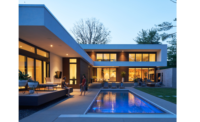The American Society of Interior Designers has unveiled an in-depth case study showcasing the impact of design. The home featured is the personal residence of Laura Britt, ASID and her family of three. Britt’s eponymous firm designed the Austin, TX house, with the challenge of building a healthy, sustainable, smart, and high-performing home with a strong connection to the outdoors. Britt and her son also suffer from respiratory ailments, so she explored ways to overcome these through design. The final result, “Gradients of Green,” is a home for the modern family that highlights the rich benefits of thoughtful universal and green design innovations.
By using various healthy and sustainable design strategies in the architecture, spatial layout, and overall product selection, the project created a healthy building inside and out. The WELL Building Standard was referenced throughout, with a focus on air quality, energy efficiency, and water conservation. This holistic project achieves impressive results that prove the valuable, tangible impact of design, including:
- Reducing waste by donating the original home to another family rather than adding demolition waste to the landfill.
- Producing more energy by solar array than consumed (from June 2017-May 2018, solar panels produced 14,040 KwH and the house consumed 11,093 KwH).
- Implementing a tankless water heater, only igniting when hot water is needed. This change uses less energy than a standard electric water heater and reduces CO2 output compared to traditional tank heaters.
- Installing electrical lighting fixtures specified as LED for high-efficiency purposes, using as little as 15% of the energy of conventional lighting with a life expectancy of up to 50,000 hours.
For more information on the Gradients of Green home and its other elements, view the project.












